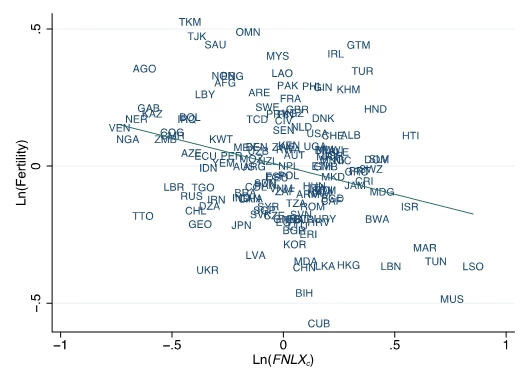Attempts to understand population growth and the determinants of fertility date as far back as the late 1700s, when Thomas Malthus wrote ‘An Essay on the Principle of Population.’
Postulating that fertility decisions are influenced by women’s opportunity cost of time (Becker, 1960), choice over fertility has been incorporated in more recent times into growth models in order to understand the joint behavior of population and economic development throughout history. The large majority of existing analyses examine individual countries in a closed-economy setting. However, in an era of ever-increasing integration of world markets, the role of globalization in determining fertility can no longer be ignored.
In a recent study (Do, Levchenko, and Raddatz, 2014), we examine both theoretically and empirically the impact of comparative advantage in international trade on fertility outcomes. Our conceptual framework is based on the following observations:
First, women bear a disproportionate burden of raising children. While there has been a debate on whether this empirical regularity (see, e.g., Angrist and Evans, 1998; Guryan et al., 2008) is due to nature or nurture (see, e.g. Alesina et al., 2013), the outcome remains that a child reduces a woman’s labor supply more than a man’s. Second, industries vary a great deal in the gender mix of their labor force: some industries employ primarily women, others primarily men. For example, female workers account for as little as 8-9 percent on employment in industries such as heavy machinery, and as much as 60-70 percent in some types of textiles and apparel.Third, differences in technology and resource endowments will lead some countries to have a comparative advantage in industries that happen to hire a lot of women.
Then, countries with comparative advantage in female-intensive goods will exhibit lower fertility. Our main thesis thus combines Becker’s hypothesis that fertility is affected by women’s opportunity cost of time with the insight that this opportunity cost is higher in countries with a comparative advantage in industries that have higher demand for female labor.
We provide empirical evidence for this phenomenon using industry-level export data for 61 manufacturing sectors in 145 countries over 5 decades. We combine the classification of industries according to their intensity of female labor use with data on countries’ export shares to construct, for each country and time period, a measure of its female labor needs of exports. This index captures the degree to which a country’s comparative advantage is in female-intensive sectors.
We use this measure to show empirically that fertility is lower in countries with a comparative advantage in female-intensive sectors. We employ both cross-sectional specifications with instrumental variables and panel specifications with fixed effects. The result is robust to the inclusion of a large number of other covariates of fertility, and is economically significant. Moving from the 25th to the 75th percentile in the distribution of the female labor needs of exports lowers fertility by as much as 20 percent, or about 0.64 births per woman.
As a simple illustration of the results, we can compare countries with the largest positive and negative changes in female labor needs of exports between the 1960s and today. For the countries with the largest observed increases in female labor needs of exports, the common pattern is that they change their specialization from agriculture-based sectors to wearing apparel. For instance, in the 1960s 80% of exports from Cambodia were in the Food Products sectors. By the 2000s, 85% of Cambodian exports are in Wearing Apparel. Since Food Products sectors are right in the middle of the distribution of female intensity, and Wearing Apparel is the most female-intensive sector, this type of specialization change will lead to large increases in female labor needs of exports.
The largest observed decreases in female labor needs of exports are driven by the discovery of natural resources. For instance, Niger was an agricultural exporter in the 1960s, with nearly 80% of exports in Food Products. By the 2000s, over 60% of Niger’s exports were in Refined Petroleum Products and Nuclear Fuel. The natural resource-based sectors are among the least female-intensive, with the share of female workers in total employment of 0.11-0.13, which accounts for why countries with major shifts towards natural resources exhibit reductions in their female labor needs of exports.
It turns out that these two groups of countries experienced very different changes in fertility. Among the 10 countries with the largest increases in female labor needs of exports, fertility fell on average by 3.5 children per woman, from 6.5 to 3 between the 1960s and the 2000s. By contrast, in the 10 countries with the largest decreases in female labor needs of exports, fertility fell by only 1.3 children per woman over the same period, from 6.9 to 5.6. Remarkably, while these two groups had similar fertility levels in the 1960s (6.5 and 6.9), their subsequent paths were very different.
This pattern is more general. Figure 1 depicts the partial correlation between (log) fertility and (log) female labor needs of exports, after controlling for income, overall trade openness, and regional dummies. The pronounced negative relationship is evident.
Fertility is an economic decision, and like all economic decisions has long been considered an appropriate – and important – subject of analysis by economists. We now understand that international trade, or more precisely comparative advantage, matters for the fertility decisions. Our results emphasize the heterogeneity of the effects of trade on countries’ industrial structures and gender outcomes. From a policy perspective, our results suggest that it will be more difficult for countries with technologically-based comparative advantage in male-intensive goods to undertake policy measures to reduce the gender gap, potentially leading to a slower pace of women’s empowerment. In an increasingly integrated global market, the road to female empowerment is paradoxically very specific to each country’s productive structure and exposure to international trade.
Figure 1: Partial Correlation Between Fertility and Female Labor Needs of Exports (FNLX)




Join the Conversation